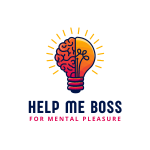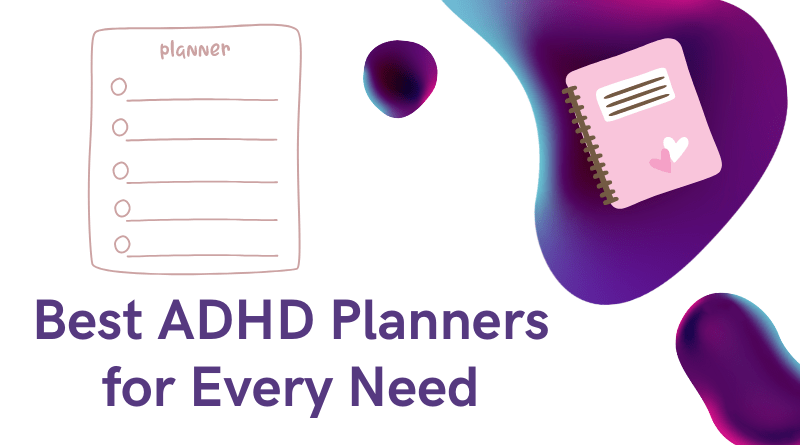For those living with ADHD, staying organized and on top of tasks can feel like an uphill battle. Traditional planners, with their layouts and details, often fall short, leaving you feeling frustrated and defeated. But fear not! A world of ADHD planners is designed to cater to your unique needs and help you.
This guide dives deep into the world of ADHD planners, exploring:
- The challenges of traditional planners for ADHD brains
- Essential features to look for in an ADHD planner
- Popular ADHD planner options (both paper and digital)
- Tips for choosing and using your ideal planner
By the end, you’ll find the planner that becomes your secret weapon for conquering your to-do list and achieving your goals.
Why Traditional ADHD Planners Don’t Click with Brains
Traditional planners often fall flat for those with ADHD due to a few key factors:
- Visual Clutter: Busy layouts with excessive text, graphics, or unnecessary sections can be overwhelming and distracting for someone with ADHD.
- Limited Flexibility: Rigid formats don’t accommodate the dynamic nature of ADHD. You might need to switch gears suddenly or break down tasks into smaller chunks on the fly.
- Lack of Customization: A “one-size-fits-all” approach doesn’t work with ADHD. You might need specific sections for brain dumps, habit trackers, or visual aids for prioritizing tasks.
- Limited Focus on Prioritization: Traditional planners often neglect prioritization tools, leaving you unsure of what needs your immediate attention.
- No Support for Time Management: Features like time blocking or hourly breakdowns, crucial for managing time with ADHD, are often absent.
These shortcomings can lead to planner abandonment, fueling disorganization and frustration.
Must-Have Features for an ADHD Planner
Now that we understand why traditional planners fall short let’s explore the features that make an ADHD planner a game-changer:
- Simplicity and Clarity: The layout should be clean, uncluttered, and easy to navigate. Ample writing space and clear headings are essential.
- Flexibility and Customization: To personalize your planning system, look for options with interchangeable layouts, inserts, or discbound features.
- Visual Appeal: Consider color-coding, stickers, or highlighters to create visual cues that enhance focus and organization. Some planners even have pre-designed layouts with color and icons for a more engaging experience.
- Task Management Features: Prioritization tools like star systems, bullet points, or space for numbering tasks can help you tackle the most important things first.
- Time Management Tools: Features like time blocking, hourly breakdowns, or daily schedules can be crucial for managing time effectively.
- Goal Setting and Progress Tracking: Dedicated sections for setting goals, breaking them down into actionable steps, and tracking progress can provide a sense of accomplishment and fuel motivation.
- Habit Tracking: Building and maintaining positive habits is essential for managing ADHD. A dedicated space for habit tracking allows you to monitor progress and celebrate successes.
- Brain Dump Sections: Let your thoughts flow freely! Dedicated space for brain dumps allows you to capture fleeting ideas or worries without focusing on the task.
- Reflection Prompts: Regularly reflecting on how you used your planner can help you identify areas for improvement and adjust your approach. Some planners even include built-in prompts to guide your reflection process.
- Positive Reinforcement: Look for planners incorporating positive affirmations or motivational quotes to keep you inspired and on track.
The ideal ADHD planner should be a tool you enjoy using, not a chore. Consider choosing a planner with aesthetics that appeal to you, whether it’s vibrant colors, playful fonts, or minimalist designs.
Popular ADHD Planner Options
Now that you know what features to look for, let’s explore some popular ADHD planner options:
Paper Planners:
-
Imperfect Inspiration Discbound ADHD Planner: This planner stands out for its high level of customization. Featuring disc-bound discs, you can easily add or remove pages, inserts, and layouts to create a system that perfectly suits your needs. It also includes prompts for tasks, self-care, and goal setting.
-
Panda Planner Classic: This planner offers a clean, minimalist layout with ample writing space. For those who prefer a subtle and stylish design, the Panda Planner is a great choice. Don’t be fooled by its simplicity, it still offers features like habit trackers and weekly goal sections.
-
Happy Planner: If you thrive on visual stimulation and fun, the Happy Planner might be your perfect match. Filled with bright colors, stickers, and inspirational quotes, it injects a dose of joy into the planning process. It offers various layouts and features.
Also Read How Doctors with ADHD Deliver Exceptional Care
-
Bullet Journal: A bullet journal is a fantastic option for the ultimate customization. This isn’t a pre-designed planner but a system that allows you to create layouts and sections using a dotted notebook. The flexibility is unmatched, but it does require some upfront effort and creativity to set up. Many online resources and communities are dedicated to bullet journaling for ADHD, offering inspiration and guidance.
-
Passion Planner: This planner is known for its focus on goal setting and long-term vision. It includes sections for identifying your core values, creating a life mission statement, and setting yearly, monthly, and weekly goals. For those who crave a holistic approach to planning that goes beyond daily tasks, the Passion Planner is a great choice.
-
Moleskine Classic Daily Planner: If you prefer a more traditional layout focusing on daily scheduling, the Moleskine Classic Daily Planner offers a solid option. It provides a full page for each day with hourly breakdowns, allowing you to plan your schedule in detail. While not as customizable as other options, its simplicity and classic design might appeal to some.
Digital ADHD Planners & Apps:
-
Focus Keeper: This app utilizes the Pomodoro Technique, a time management method that breaks work down into focused 25-minute intervals with short breaks in between. It’s a great tool for those with ADHD who struggle with maintaining focus for long periods.
-
Evernote: Although not designed explicitly for ADHD, Evernote’s versatility makes it a powerful tool for organization. You can create notes, checklists, to-do lists, and even import web clippings or audio recordings. All your information is searchable and accessible from any device.
-
Todoist: This app boasts a clean, user-friendly interface with robust task management features. You can create tasks, set reminders, categorize tasks by project, and track progress. It also integrates with other productivity tools and offers a free version with limited features.
-
TickTick: This app is another popular option for managing to-do lists. It allows you to create tasks with subtasks, set priorities, and collaborate with others. The free version offers many features, with premium options unlocking additional functionalities.
-
Forest: This app gamifies the task management process. When you start a task, you plant a virtual tree, which grows as you stay focused. Suppose you get distracted and leave the app, your tree withers. It’s a fun and visually appealing way to encourage focus and avoid procrastination.
Choosing the Right Planner for You
With so many ADHD planner options available, choosing the right one can feel overwhelming. Here are some tips to guide your decision:
- Consider your planning style: Do you prefer a structured layout or a more free-form approach? Do you thrive on visual aids or need a minimalist design?
- Identify your most significant challenges: Are you struggling with time management, prioritization, or task completion? Choose a planner with features that address your specific needs.
- Experiment! Don’t be afraid to try different planners until you find one that resonates with you. Many offer free printables or trial versions.
- Read reviews and watch tutorials: Gain valuable insights from others with ADHD who have tried different planners.
Using Your Planner Effectively
Once you’ve found the perfect planner, here are some tips to maximize its effectiveness:
- Schedule dedicated planning time: Set aside time each day or week to review your planner, update tasks, and plan.
- Be realistic: Don’t overload your schedule. Start with achievable goals and gradually increase as you build confidence.
- Break down large tasks: Feeling overwhelmed by a big project? Chunk it down into smaller, more manageable steps.
- Use visuals: Utilize color coding, stickers, or highlighters to categorize tasks, prioritize items, or create visual cues that enhance focus.
- Review and reflect: Regularly reflect on your use of the planner. Are there sections you’re not using? Do you need to adjust your approach?
- Celebrate your wins: Acknowledge your accomplishments, no matter how small. This will keep you motivated and on track.
Remember, your planner is a tool, not a taskmaster. Use it to empower yourself, not add to your stress. With the right planner and strategies in place, you can conquer the challenges of ADHD and thrive in all areas of your life.
Bonus Tips
- Create a dedicated planning space: Having a designated area for planning can help you develop a routine and reduce distractions. This could be a specific desk, table, or a comfortable corner in your favorite chair.
- Pair planning with a focus booster: Light background music, nature sounds, or even fidget toys can help some people with ADHD maintain focus while planning. Experiment and see what works best for you.
- Integrate your planner with other productivity tools: Many digital planners offer integrations with calendar apps, to-do list apps, or note-taking apps. This can create a streamlined workflow and ensure all your information is centralized.
- Don’t be afraid to get messy: Planning doesn’t have to be perfect! Cross things out, rewrite tasks, and embrace the dynamic nature of your needs. Your planner is a living document, not a museum exhibit.
- Seek support and accountability: Connect with others who understand the challenges of ADHD. Online communities, support groups, or productivity coaches can offer valuable guidance and motivation.
Beyond the Planner: Additional Strategies for Managing ADHD
While a great planner can be a powerful tool, it’s just one piece of the puzzle for managing ADHD. Here are some additional strategies to consider:
- Develop healthy routines: Establishing consistent sleep schedules, meal times, and exercise routines can significantly improve focus and overall well-being.
- Mindfulness and meditation: Mindfulness techniques like meditation or deep breathing can help manage stress, improve focus, and enhance emotional regulation.
- Cognitive-behavioral therapy (CBT): This form of treatment can equip you with strategies for managing negative thought patterns and developing coping mechanisms for dealing with challenges associated with ADHD.
- Medication: Talk to your doctor about whether medication might be a helpful addition to your ADHD management plan. Medication can be a powerful tool for some people with ADHD, but it’s essential to find the proper dosage and medication type for your specific needs.
Conclusion
Living with ADHD can be a challenge, but it doesn’t have to hold you back. By implementing the strategies outlined in this guide, including finding the perfect ADHD planner and incorporating other helpful practices, you can take control of your time, achieve your goals, and live a productive and fulfilling life. Remember, you are not alone in this journey. There are countless resources available to support you, and with the right approach, you can thrive with ADHD.

